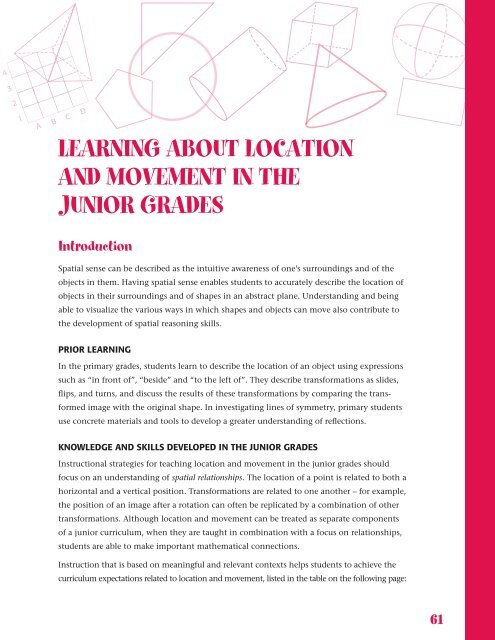Geometry and Spatial Sense, Grades 4 to 6 - EduGains
Geometry and Spatial Sense, Grades 4 to 6 - EduGains
Geometry and Spatial Sense, Grades 4 to 6 - EduGains
You also want an ePaper? Increase the reach of your titles
YUMPU automatically turns print PDFs into web optimized ePapers that Google loves.
LEArnInG ABout LoCAtIon<br />
And MovEMEnt In thE<br />
JunIor GrAdES<br />
Introduction<br />
<strong>Spatial</strong> sense can be described as the intuitive awareness of one’s surroundings <strong>and</strong> of the<br />
objects in them. Having spatial sense enables students <strong>to</strong> accurately describe the location of<br />
objects in their surroundings <strong>and</strong> of shapes in an abstract plane. Underst<strong>and</strong>ing <strong>and</strong> being<br />
able <strong>to</strong> visualize the various ways in which shapes <strong>and</strong> objects can move also contribute <strong>to</strong><br />
the development of spatial reasoning skills.<br />
PRIOR LEARNING<br />
In the primary grades, students learn <strong>to</strong> describe the location of an object using expressions<br />
such as “in front of”, “beside” <strong>and</strong> “<strong>to</strong> the left of”. They describe transformations as slides,<br />
flips, <strong>and</strong> turns, <strong>and</strong> discuss the results of these transformations by comparing the trans-<br />
formed image with the original shape. In investigating lines of symmetry, primary students<br />
use concrete materials <strong>and</strong> <strong>to</strong>ols <strong>to</strong> develop a greater underst<strong>and</strong>ing of reflections.<br />
KNOWLEDGE AND SKILLS DEVELOPED IN ThE JUNIOR GRADES<br />
Instructional strategies for teaching location <strong>and</strong> movement in the junior grades should<br />
focus on an underst<strong>and</strong>ing of spatial relationships. The location of a point is related <strong>to</strong> both a<br />
horizontal <strong>and</strong> a vertical position. Transformations are related <strong>to</strong> one another – for example,<br />
the position of an image after a rotation can often be replicated by a combination of other<br />
transformations. Although location <strong>and</strong> movement can be treated as separate components<br />
of a junior curriculum, when they are taught in combination with a focus on relationships,<br />
students are able <strong>to</strong> make important mathematical connections.<br />
Instruction that is based on meaningful <strong>and</strong> relevant contexts helps students <strong>to</strong> achieve the<br />
curriculum expectations related <strong>to</strong> location <strong>and</strong> movement, listed in the table on the following page:<br />
61

















